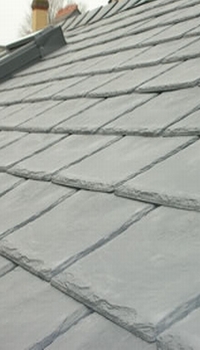
Slate Roofing
Roof slates are derived from fine-grained sand-free clay sediments. Roof slate has characteristic cleavage planes which were produced when the clay was metamorphosed. Roof slate can be split into thin section (typically 4-10 mm for roofing slates) giving a natural riven finish. Roof slate may also be sawn, sanded, fine rubbed, honed, polished, flame textured or bush hammered.
Roof slate is available in a wide range of colours, including blue/grey, silver grey and green roof slate from the Lake District; blue, green grey and plum red roof slate from North Wales; and grey roof slate from Cornwall. Roof slate is imported from Ireland (grey/green), Canada (blue/grey), France (blue/grey) and Spain (blue/black). Spain is the world's largest producer of roofing slates.
Roof slate is strong and resistant to acid and frost. It lasts up to 400 years as a roofing material. The minimum recommended pitch for a natural slate roof is 20 degrees under sheltered or moderate exposure and 22.5 degrees under severe weather exposure. Fixing nails should be of copper or aluminium.

Brief History of Welsh Slate
The use of slate in the area goes back to the Roman period. The fort at Segontium, (Caernarfon), originally had tiled roofs, which were replaced at a later date with slate. Some of the floors were made of slate slabs in the fourth century. But slate was also used in a much earlier Roman fort at Caer Llugwy, between Capel Curig and the Conwy Valley two centuries before. Slate was used for roofing the eight towers of Conwy Castle between 1283-87. Indeed, during the Welsh wars of Independence, Edward I, of England, while visiting the copper mines of Drws y Coed, is reputed to have stayed at a house in the Nantlle Valley roofed with slates from the Cilgwyn Quarry. In 1317, the great hall of Llywelyn II, (Llywelyn the Last), was removed from Conwy to Caernarfon Castle and slated by one 'Henry le Scaltiere.'
Around 1358-60, building repairs were carried out at Chester, under the supervision of the Black Prince, when '21,000 slate stones' were bought for the roof of the great stable at Chester Castle. And when Richard II, of England arrived at Conwy in 1399, a year before the Rebellion of Owain Glyndwr.
John Leland during his travels between 1536-39 remarked that 'the houses within the town of Oswestre be of tymbre and slated' and at Is Dulas, on the eastern side of the River Dulas in Denbighshire, 'they dig oute slate stones to kyver houses.' Slates were also used on houses in Wrexham during the reign of Elizabeth I. During the episcopacy of William Morgan, (translator of the Bible into Welsh) at St. Asaph, (1601-04) the cathedral chancel was slated. In 1682, more slating with Penrhyn slates took place and during renovation in the 1930's, these slates, which were by then over 250 years old were strong enough to be re used on new timbers.
Another secular building, with ecclesiastical links was Plas y Gogarth, near Llandudno. This was owned by the Bishop of Bangor, and which was roofed in the thirteenth century. All in all, the picture we have is of slates being used on the better kind of house in North Wales at this time, a time which saw a great deal of building activity. Slates from the Glyn Ceiriog area were available in 1675.
However, it must be kept in mind that apart from castles and cathedrals, it was not uncommon in Wales to use slates for roofing at this time. Any transportation involved the use of ships. Indeed, the chief export of the area by Tudor times was slate, as up to 1603, there are references of slate being exported from Aberogwen(Bangor), to Dublin and Carlingford in Ireland as well as the Foryd (Rhyl), St. Asaph and Chester. Slates from Pembrokeshire were exported to the south east coast of Ireland as well as Bristol.
It is also interesting to note that slates from Antwerp were imported into London in 1567 to re-roof the Royal Exchange at London. More recently, Welsh slate was used to roof the Palace of Westminster in the nineteenth century, for the electricity panels of the Cunard liners, Queen Mary and the Queen Elizabeth in the 1930's, as a damp course for the new cathedral at Guildford in 1960 as well as re-roofing the whole of Downing Street in 1962-63.
Slate Types
There are two main types of slate natural and man made. Natural slate is sourced from China, Brazil, Belgium and Wales. Examples are shown below. There is a list of brochures to download underneath.

Natural Welsh Slate

Brazilian Slate

Chinese Slate
Slate & Tile Brochures
More Information
Work Guarantee
All work undertaken by C. Stevens Roofing is covered by clear, written guarantees including workmanship and material, to give you added confidence. Our guarantee is backed by a long established reputation in the business and is respected and valued by works professionals throughout the county.
Insurance Guarantee

HomePro Insurance Backed Guarantees helping you to protect your investment. Although home improvement is one of the safest forms of financial investment, there is one pitfall that can be overlooked.
Most contractors issue a guarantee for the work they have undertaken, we are no different. However, thousands of contractors cease to trade each year.
If your chosen contractor ceased to trade HomePro will match the terms of the contractors original guarantee.
